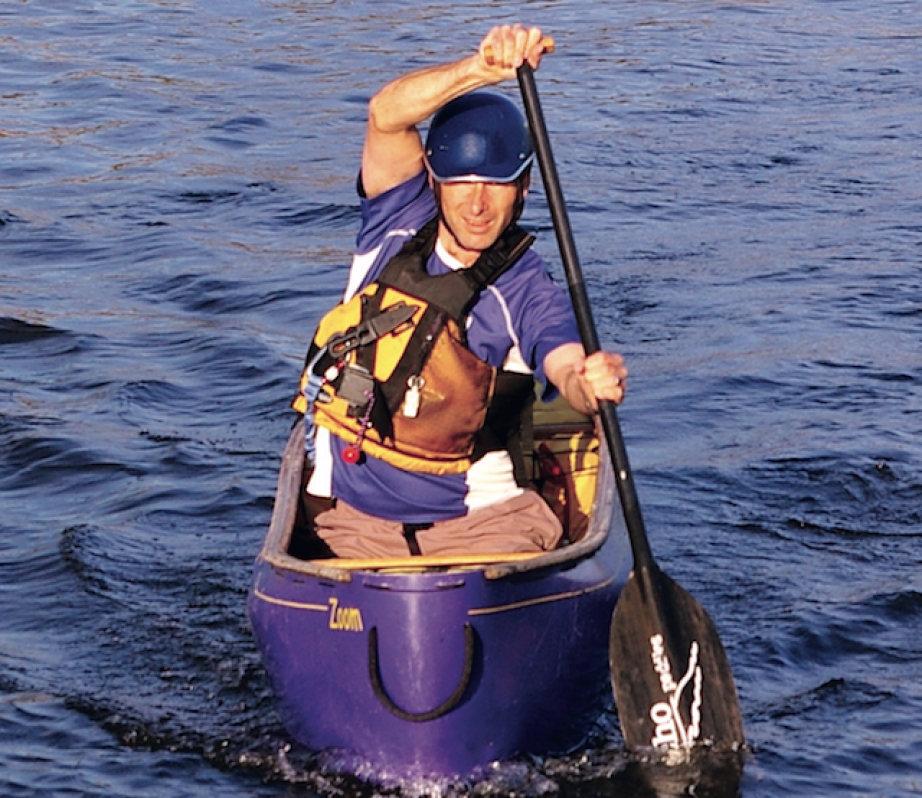Forward Stroke Rebirth
The forward stroke is enjoying a renaissance as more open canoeists use it as not just a method of propulsion, but as a means to steer their canoes. A proven skill that harkens back to the earliest C1ers, power steering is the ability to control your solo boat while using nothing more than basic forward strokes. The key is understanding that the stroke can be broken down into distinct variables that allow you to easily guide the canoe in whichever direction you wish to go. All this without having to draw from the traditional set of rudder strokes, which slow your canoe and waste valuable energy.
Power steering with the 2×4 technique uses the four main variables which define the relationship between any stroke and your boat. These are: stroke cadence or timing; stroke position; paddle angle; and boat tilt.
Individually or together, these stroke elements are used to change the direction of your canoe while paddling with forward strokes. Add the cross-forward stroke playing with these same elements on your offside, and you achieve total boat control using only forward strokes. It’s also easy to remember. Think of the two forward strokes and the four variables, and voila, you have the 2×4 technique.
2×4 Forward Stroke Technique
Power steering builds on the concept of carving, or paddling your canoe on an arcing path. To understand this, picture the canoe in motion and how the bow is cradled by bow waves. By using the 2×4 technique you can control how these bow waves direct the canoe’s path, much like the reins on a horse. By simply allowing a wave on one side of the canoe to be bigger than the wave on the opposite side, the larger wave will push the canoe into an arcing path. Canoeists “steer” by controlling the wave effect by paddling on the inside of this arcing path in such a way as to resist, or enhance, the circular route of the canoe.
The easiest way to get the sensation of paddling a controlled arc is to experiment with stroke timing. Get your canoe moving by alternating three to four forward and cross-forward strokes. Finish with a cross-forward stroke, pause and wait for the canoe to arc toward your onside.
Now continue paddling an arcing path with just forward strokes.
If the canoe begins to straighten out, slow or pause the timing of your strokes and allow the canoe to regain its arcing path. If the arc is sharper than you desire, simply increase your stroke rate to straighten your path. The timing of when you apply power to your stroke has the effect of tightening or widening your arc.
Stroke position has the same effect on the diameter of your arc. By positioning your stroke ahead of your knee you will experience a tightening arc. Pulling past your knee toward your hip causes the canoe to straighten its path.
Similarly, stroking with a nearly vertical paddle shaft keeps the canoe travelling in an arcing path, while an angled shaft can dramatically straighten your path.
Finally, paddling the canoe with more tilt to the hull uses the chine to carve a tight arc, while paddling with a flatter hull favours a straighter course.
All these elements apply equally to the offside with the cross-forward stroke. As a result, solo paddlers have complete control for turning left or right while the boat is under power. One important rule applies for power steering: always place your strokes on the inside of the arcing canoe– never paddle on the outside.
Implications on Instruction
Often, beginners learn the 2×4 technique after their first lesson and show effective boat control for entering and exiting eddies. The implications on instruction are groundbreaking as teaching more advanced stern strokes can be delayed until paddlers reach higher novice to intermediate levels.
The bane of many solo canoeists—and their instructors—is the difficulty in getting the canoe going in a straight line from a stand still. By teaching forward and cross-forward strokes to beginners, along with a method of boat control, new paddlers quickly overcome the number-one obstacle to success in solo canoeing. Greater success surely means more new paddlers sticking with open canoeing.
The rebirth of the forward stroke as a control stroke maximizes forward speed and provides directional control. Use of various stroke elements to tighten or lessen your arc means you can carve the canoe with complete control. Power steering with the 2×4 technique makes paddling a solo canoe easy!
Andrew Westwood is an open canoe instructor at the Madawaska Kanu Centre, member of Team Esquif and author of The Essential Guide to Canoeing.
This article first appeared in the Early Summer 2008 issue of Rapid Magazine.
